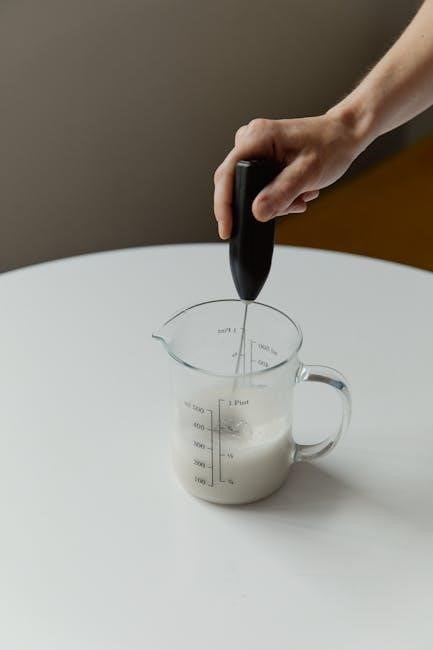A cream separator is a centrifugal device designed to separate whole milk into cream and skimmed milk, enhancing dairy processing efficiency and quality.
1.1 What is a Cream Separator?
A cream separator is a centrifugal device designed to efficiently separate whole milk into cream and skimmed milk. It operates by spinning milk at high speeds, allowing the cream to be extracted based on density differences. Typically constructed with food-grade materials like stainless steel, these devices are durable and hygienic. With adjustable settings, users can control the fat content of the cream. The separator is an essential tool in dairy processing, offering precise separation and ease of use when operated according to the provided manual instructions.
1.2 Purpose and Functionality
The primary purpose of a cream separator is to efficiently divide whole milk into cream and skimmed milk through centrifugal force. It operates at high speeds, separating components based on density, with cream being denser than skimmed milk. Designed for dairy processing, it ensures clean and precise separation, often with a productivity rate of 50-100 liters per hour. The device also removes contaminants, enhancing milk quality. Its functionality includes adjustable settings for cream fat content and variable speed controls, making it a versatile tool for both small-scale and industrial dairy applications.
1.3 Brief History and Evolution
The cream separator has evolved significantly since its inception in the late 19th century. Initially, basic centrifugal models were introduced, separating milk into cream and skimmed milk. Over time, advancements in materials and technology led to more efficient designs, including stainless steel components and variable speed controls. Modern separators now feature automation, advanced safety mechanisms, and improved productivity rates, making them indispensable in both small-scale and industrial dairy processing. This evolution reflects ongoing innovation to meet the demands of dairy production.

Key Features and Benefits
Cream separators offer high productivity, adjustable settings, and durable construction. They efficiently separate milk into cream and skimmed milk, ensuring quality and ease of maintenance.
2.1 Design and Construction
Cream separators are typically built with durable, food-grade materials like stainless steel and anodized aluminum. Their centrifugal design includes spinning discs that separate milk into cream and skimmed milk. The motor operates at variable speeds, often between 7,000 to 10,000 rpm, ensuring efficient separation. Many models feature a compact, corrosion-resistant construction, with easy-to-clean components. The design often includes an anti-froth system and adjustable settings for cream thickness. These features ensure longevity, hygiene, and optimal performance in dairy processing environments.
2.2 Productivity Rates and Efficiency
Cream separators are designed to handle various productivity rates, typically ranging from 50 to 100 liters per hour. Their efficiency is driven by centrifugal force, which separates milk into cream and skimmed milk effectively. Motor speeds, often variable between 7,000 to 10,000 rpm, ensure optimal performance. Advanced models feature electronic controls for precise adjustments, enhancing separation accuracy. Higher speeds generally improve efficiency, but proper calibration is essential for desired cream fat content. Regular maintenance and correct usage further maximize productivity, ensuring consistent results in dairy processing applications.
2.3 Safety Features
Safety is crucial when operating a cream separator. Protective clothing, gloves, and eyewear are recommended to prevent accidents. Avoid fuel spills and ensure no naked flames or smoking near the device. Emergency shutdown procedures are essential, with clear instructions provided in the manual. The separator’s durable construction, including rust-proof materials, ensures long-term reliability. Proper installation on a stable surface and adherence to maintenance guidelines further enhance safety. Always follow the user manual for safe operation and maintenance to prevent hazards and ensure efficient functionality. Regular inspections are vital for sustained safety and performance.
Installation and Assembly
Installation begins with unboxing and inventorying all parts. Wash components with soapy water, then assemble by following the manual’s step-by-step guide. Ensure all connections are secure and properly aligned for safe and efficient operation. Tighten all fasteners firmly and verify the separator is level on a stable surface before use. Always refer to the provided instructions for specific assembly details and pre-installation checks to ensure optimal performance and safety.
3.1 Unboxing and Inventory
Upon receiving your cream separator, carefully unpack and inspect all components. Verify the presence of the separator unit, bowls, spouts, and any additional accessories listed in the manual. Ensure no parts are damaged or missing. Clean each component with warm, soapy water before assembly. Organize the parts in a logical order to facilitate a smooth assembly process. Refer to the manual’s inventory list to confirm all items are included. Properly preparing and organizing the components is essential for efficient and correct assembly.
3.2 Step-by-Step Assembly Instructions
Begin by washing all components with warm, soapy water. Assemble the drum by inserting the metal pins on the key into the holes at the top. Turn the key left to loosen the nut. Attach the top bowl to the motor beam, ensuring proper alignment. Secure the skimmed milk and cream funnels to the housing. Tighten all connections firmly but avoid over-tightening. Refer to the manual for specific diagrams and alignment guides; Once assembled, ensure all parts are securely locked in place for safe and efficient operation. Proper assembly is critical for optimal performance.
3.3 Pre-Installation Checks
Before installing the cream separator, ensure all components are included and undamaged. Verify the motor, drum, and bowls are clean and free of defects. Check the power supply matches the separator’s voltage and frequency requirements. Ensure the area is clean and level for stable operation. Tighten all connections and bolts firmly. Lubricate moving parts as specified. Perform a test run without milk to ensure smooth operation and proper alignment. Consult the manual for specific pre-installation checks to guarantee safety and efficiency. Proper preparation ensures optimal performance and longevity of the equipment.

Operating Instructions
Operate the cream separator by following the pre-start checklist, ensuring all parts are secure; Start the motor, monitor the process, and adjust settings for optimal separation efficiency and safety.
4.1 Pre-Operation Checklist
Before operating the cream separator, ensure all components are securely assembled and free from damage. Check the power supply and connections for stability. Lubricate moving parts if required. Wear protective gear, including gloves and safety glasses. Verify the separator is placed on a stable, level surface. Ensure proper drainage and collection containers are in place. Review the user manual for specific model instructions. Conduct a trial run with water to ensure smooth operation before processing milk.
4.2 Starting the Separator
Ensure the power supply is stable and the separator is properly grounded. Turn the switch to activate the motor, starting at a low speed. Gradually increase the speed to the recommended level for optimal separation. Allow the machine to run empty for a few minutes to ensure smooth operation. Monitor for any unusual noises or vibrations. Once stable, slowly pour the milk into the inlet. Maintain the recommended flow rate to prevent overload and ensure efficient separation.
4.3 Adjusting Settings for Optimal Performance
Start by ensuring the separator is running smoothly. Adjust the hexagonal screw in the top bowl to regulate cream fat content and flow rate. Balance the cream and skimmed milk outlets to maintain even separation. Monitor the process and fine-tune the settings based on milk temperature and flow. Regularly check the centrifuge speed and ensure it aligns with the recommended range for optimal efficiency. Always refer to the manual for specific adjustment guidelines tailored to your separator model and operating conditions.
4.4 Monitoring the Separation Process
Monitor the cream separator during operation to ensure efficient separation. Check the flow rates of cream and skimmed milk, ensuring they align with your desired output. Visually inspect the bowls and discs for proper alignment and cleanliness. Listen for unusual noises that may indicate imbalance or wear. Regularly verify the centrifuge speed and adjust if necessary. Keep an eye on temperature levels, as this affects separation quality. Refer to the manual for specific monitoring guidelines and make adjustments to optimize performance and maintain consistent results.

Safety Precautions
Always wear protective gear, ensure proper installation, and follow manual guidelines to prevent accidents. Regular inspections and adherence to safety protocols are essential for safe operation.
5.1 General Safety Guidelines
Always read the manual carefully before use and ensure all parts are correctly assembled. Wear protective clothing, including gloves and eyewear, to avoid injury. Ensure the area is well-ventilated and free from flammable materials. Avoid fuel spills and never smoke near the separator. Keep children away from the appliance. Regularly inspect for damage or wear and tear. Follow all safety protocols to ensure safe operation, efficiency, and longevity of the cream separator.
5.2 Protective Gear Recommendations
Always wear protective gloves and eyewear when operating the cream separator to prevent injury from splashes or accidental contact. Use non-flammable, oil-resistant gloves to ensure grip and safety. Protective clothing, such as aprons or overalls, is recommended to avoid stains or splatter damage. Safety glasses with a wraparound frame provide optimal eye protection. Ensure long hair and loose clothing are tied back to avoid entanglement. Proper footwear, such as closed-toe shoes, is essential for workplace safety. Regularly inspect protective gear for wear and tear to maintain effectiveness and compliance with safety standards.
5.3 Emergency Shutdown Procedures
In case of an emergency, immediately switch off the power supply to the cream separator. Press the emergency stop button firmly to halt all operations. Evacuate the area if there is a milk spill or leakage. Do not attempt to restart the machine until it has come to a complete stop and the issue has been resolved; Ensure all moving parts have ceased before inspecting or repairing. Always follow the manufacturer’s guidelines for safe shutdown procedures to prevent accidents and ensure proper maintenance.

Maintenance and Care
Regular cleaning, lubrication, and inspection of wearable parts ensure optimal performance and longevity of your cream separator. Replace damaged components promptly to maintain efficiency and safety standards.
6.1 Daily Cleaning Routine
_daily cleaning is essential for maintaining hygiene and efficiency. Wash all components with warm, soapy water after each use. Rinse thoroughly to remove any milk residue. Dry the parts carefully to prevent rust or bacterial growth. Regularly inspect and clean the centrifuge bowl, discs, and funnels. Lubricate moving parts as recommended to ensure smooth operation. Always follow the manufacturer’s guidelines for cleaning products and techniques to maintain the separator’s performance and longevity._
6.2 Regular Maintenance Checks
Regular maintenance ensures optimal performance and extends the separator’s lifespan. Check all bolts and screws for tightness, and inspect for wear or damage. Lubricate moving parts periodically to prevent friction. Examine the centrifuge bowl, discs, and seals for signs of wear and replace them if necessary. Ensure proper alignment of components after reassembly. Verify that all electrical connections are secure and functioning correctly. Schedule professional servicing if unusual issues arise. Consistent checks help maintain hygiene, efficiency, and safety, ensuring reliable operation over time.
6.3 Troubleshooting Common Issues
Troubleshooting common issues ensures smooth operation of the cream separator. Low cream yield may result from improper milk temperature or clogged outlets. Excessive noise or vibration could indicate unbalanced parts or worn bearings. Milk leakage often stems from loose connections or damaged seals. Regularly inspect and clean components, tighten loose parts, and replace worn items. If issues persist, consult the user manual or contact professional support. Addressing problems promptly prevents further damage and maintains efficiency, ensuring reliable performance and high-quality separation results.
6.4 Replacement of Wearable Parts
Regular replacement of wearable parts is essential for maintaining optimal performance. Components like seals, gaskets, and bearings may wear out over time, leading to reduced efficiency or leakage. Turn off the separator, disconnect power, and follow the manual’s disassembly instructions. Replace worn parts with genuine or compatible alternatives. Reassemble carefully, ensuring all connections are secure. Timely replacement prevents further damage and ensures consistent cream quality. Always refer to the user manual for specific guidance on part replacement and compatibility to maintain your separator’s longevity and functionality effectively.

Understanding the Separation Process
The separation process involves advanced centrifugal technology to divide milk into cream and skimmed milk, ensuring efficient processing and consistently high-quality dairy products for optimal results.
7.1 How Centrifugal Separation Works
Centrifugal separation uses high-speed rotation to separate milk into cream and skimmed milk. The milk is spun in a centrifuge bowl, causing heavier skimmed milk to move outward, while cream, being lighter, collects near the center. This efficient process ensures clean, precise separation, with adjustable speed settings to optimize results for different milk types and desired cream fat content, making it a reliable method for high-quality dairy processing.
7.2 Factors Affecting Cream and Skimmed Milk Quality
The quality of cream and skimmed milk is influenced by factors such as milk temperature, fat content, and centrifuge speed. Higher milk temperatures can improve separation efficiency but may affect cream consistency. Proper adjustment of the centrifuge’s speed ensures optimal separation, while worn or damaged parts can lead to contamination. Regular cleaning and maintenance of the separator are crucial to prevent bacterial growth and maintain hygiene standards, ensuring high-quality cream and skimmed milk output consistently.
7.3 Adjusting for Desired Cream Fat Content
To achieve the desired cream fat content, adjust the separator’s settings by modifying the disc stack or the regulating screw. Check the fat content regularly using a lactometer. Start with small adjustments, as significant changes can affect separation efficiency. Ensure the separator is operating at the recommended speed for optimal results. Refer to the manual for specific guidance on adjusting your model. Proper calibration ensures consistent cream quality, meeting your processing needs effectively.

Accessories and Spare Parts
Accessories include stainless steel bowls, discs, and funnels, while spare parts like seals and gaskets ensure longevity. Order from authorized dealers for compatibility and quality.
8.1 Essential Accessories
Essential accessories for your cream separator include stainless steel bowls, discs, and funnels, which ensure durable and hygienic operation; Additional items like cleaning brushes and oil for maintenance are crucial. These accessories are designed to enhance performance and longevity. Always source them from authorized dealers to guarantee compatibility and quality standards. Proper use of these accessories ensures optimal functionality and adherence to safety guidelines outlined in the manual. Regularly inspect and replace worn-out parts to maintain efficiency and prevent operational issues.
8.2 Ordering Spare Parts
When ordering spare parts for your cream separator, always refer to the provided manual or manufacturer’s instructions for accurate part numbers. Ensure compatibility by contacting authorized dealers or the manufacturer directly. Verify warranty coverage for new or replacement parts. Proper documentation, including model number and detailed descriptions, is essential for swift processing. Avoid third-party sellers to maintain quality and compliance with safety standards. Regularly check for updates or recalls to ensure optimal performance and longevity of your equipment.
8.3 Compatibility and Quality Standards
Ensure all spare parts meet the manufacturer’s compatibility and quality standards to maintain optimal performance. Verify that components are made from food-grade materials, such as stainless steel or anodized aluminum, to ensure durability and hygiene. Adhere to the manual’s guidelines for compatibility to avoid malfunctions. Always purchase parts from authorized dealers to guarantee compliance with safety and quality regulations. Regularly check for updates or recalls to ensure your equipment remains up-to-date with industry standards for efficient and safe operation.

Optimizing Performance
Optimize your cream separator’s performance by adjusting settings, monitoring processes, and ensuring proper milk temperature and speed. Follow manual guidelines for ideal cream quality and efficiency.
9.1 Milk Temperature and Its Impact
Milk temperature significantly affects the cream separation process. Ideal temperatures range between 35°C and 40°C for optimal efficiency. Lower temperatures can reduce cream yield, while higher temperatures may damage equipment or alter milk quality. Ensuring the correct temperature enhances cream fat content and skimmed milk quality. Always monitor and maintain the recommended temperature range for consistent and efficient separation performance.
9.2 Understanding Speed Settings
The cream separator operates at variable speeds, typically ranging from 7,000 to 10,000 rpm, depending on the model. Adjusting the speed allows for precise control over the separation process. Higher speeds generally improve efficiency but may reduce cream quality. Lower speeds are ideal for thicker cream or colder milk. Proper speed adjustment ensures optimal balance between cream and skimmed milk output, maintaining desired fat content and overall separation quality. Always refer to the manual for specific speed recommendations tailored to your equipment and operational needs.
9.3 Balancing Cream and Skimmed Milk Output
Balancing cream and skimmed milk output ensures optimal separation efficiency. The separator is factory-set to deliver around 10% cream from whole milk at 35°C. Adjustments can be made using the hexagonal screw in the top bowl to achieve desired cream fat content. Factors like milk temperature, speed settings, and separator design influence this balance. Monitoring the output regularly and fine-tuning the settings helps maintain consistent quality. Proper balancing ensures maximum efficiency and meets specific dairy processing requirements, as outlined in the user manual.

Troubleshooting Common Issues
Troubleshooting common issues with your cream separator involves addressing problems like low cream yield, excessive noise, or milk leakage. Refer to the manual for specific solutions and guidance to resolve these issues efficiently and maintain optimal performance.
10.1 Low Cream Yield
Low cream yield can occur due to improper adjustment of the separator or insufficient milk temperature. Check if the hexagonal adjusting screw is set correctly to achieve the desired cream fat content. Ensure the milk temperature is within the recommended range, typically around 35°C, for optimal separation. Additionally, verify that the feed rate and bowl speed are balanced to avoid overloading the separator. Refer to the manual for specific guidance on adjusting settings to improve cream yield and ensure efficient operation.
10.2 Excessive Noise or Vibration
Excessive noise or vibration may indicate improper assembly, unbalanced parts, or worn components. Ensure the separator is securely installed on a level surface and all bolts are tightened properly. Check for loose connections or misaligned parts, especially around the motor and bowl assembly. Inspect wearable parts like bearings or seals for damage and replace them if necessary. Refer to the manual for troubleshooting steps, and perform a test run without milk to identify the source of the issue. Addressing these factors will help restore smooth operation.
10.3 Milk Leakage or Spillage
Milk leakage or spillage can occur due to improper assembly, worn gaskets, or loose connections. Ensure all seals and connections are tight and free from damage. Check the bowl gasket and cream/skim milk outlets for wear and replace if necessary. Verify that the separator is properly aligned and the drain is correctly positioned. Regularly inspect and maintain all parts to prevent leaks. If issues persist, consult the manual or contact a professional for assistance. Proper maintenance will help minimize spillage and ensure efficient operation.

User Manual Highlights
The user manual provides essential safety information, operation guides, maintenance tips, and warranty details to ensure optimal performance and longevity of your cream separator.
11.1 Key Sections to Focus On
The manual emphasizes essential sections for safe and efficient operation, including pre-operation checks, step-by-step assembly, and maintenance routines. It highlights safety guidelines, troubleshooting tips, and warranty details. Users should prioritize understanding installation steps, adjusting settings for optimal performance, and emergency shutdown procedures. The manual also provides clarity on compatible spare parts and offers practical advice for maintaining hygiene and longevity of the cream separator. Familiarizing yourself with these sections ensures smooth functionality and maximizes the appliance’s lifespan.
11.2 Important Safety Information
The manual stresses wearing protective gloves, clothing, and hand cream to prevent injuries. Avoid fuel spills, smoking, or open flames near the device. Proper handling is crucial to prevent accidents. Regularly inspect parts for wear and tear. Always follow the instructions provided in the manual. Ensure emergency shutdown procedures are understood and accessible. These precautions ensure safe operation, protecting both the user and the equipment. Adhering to these guidelines maximizes safety and efficiency while using the cream separator.
11.3 Warranty and Support Details
Your cream separator is backed by a comprehensive warranty covering manufacturing defects for a specified period. Regular maintenance, as outlined in the manual, is required to maintain warranty validity. Contact customer support for any inquiries or repairs. Genuine spare parts are recommended to ensure optimal performance. Refer to the manual for detailed warranty terms and conditions. Support teams are available to assist with troubleshooting or technical queries, ensuring your separator operates efficiently throughout its lifespan.
By following the guidelines in this manual, you ensure optimal performance and longevity of your cream separator. Proper use and regular maintenance guarantee efficiency and safety. Thank you for choosing our product.
12.1 Summary of Best Practices
Always adhere to the user manual instructions for optimal performance. Ensure proper installation, assembly, and pre-operation checks. Regularly clean and maintain the separator to prevent contamination. Follow safety guidelines, including wearing protective gear and avoiding overloading. Monitor the separation process and adjust settings as needed. Keep the manual handy for troubleshooting and maintenance guidance. Proper care and adherence to these practices will extend the lifespan and efficiency of your cream separator.
12.2 Final Tips for Longevity and Efficiency
For optimal longevity and efficiency, ensure proper usage, regular maintenance, and adherence to the manual. Clean the separator daily and descale periodically to prevent damage. Maintain consistent milk temperatures for better fat separation. Lubricate moving parts and inspect for wear. Store the unit in a dry, cool place when not in use. Always refer to the manual for troubleshooting complex issues. By following these guidelines, you can ensure your cream separator performs efficiently and lasts for years.
